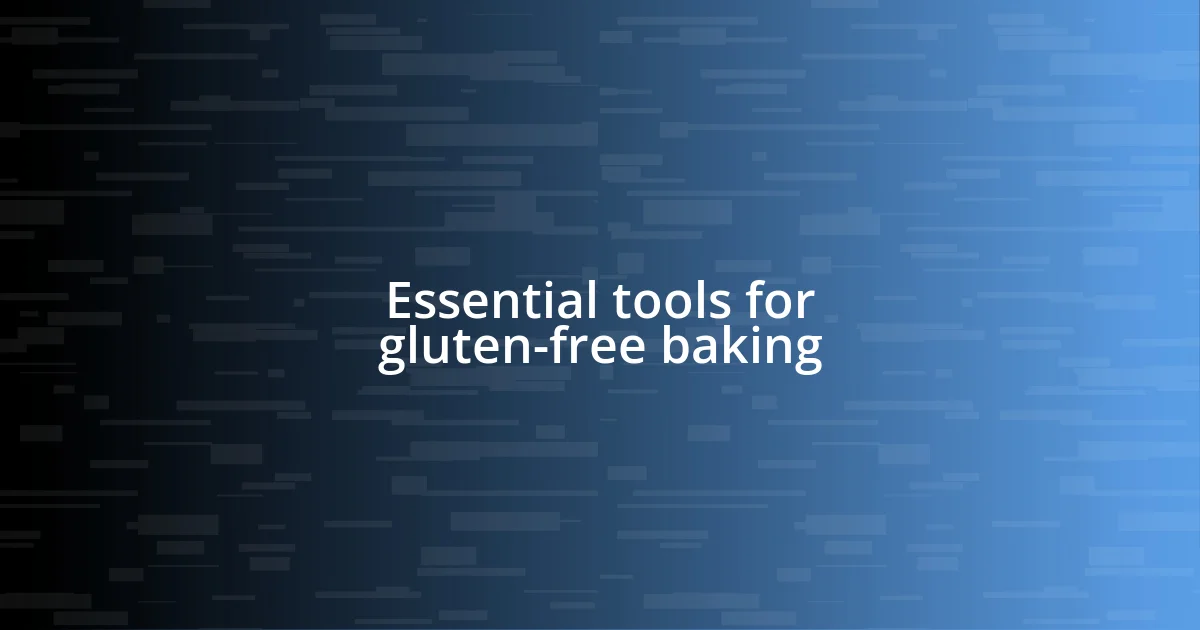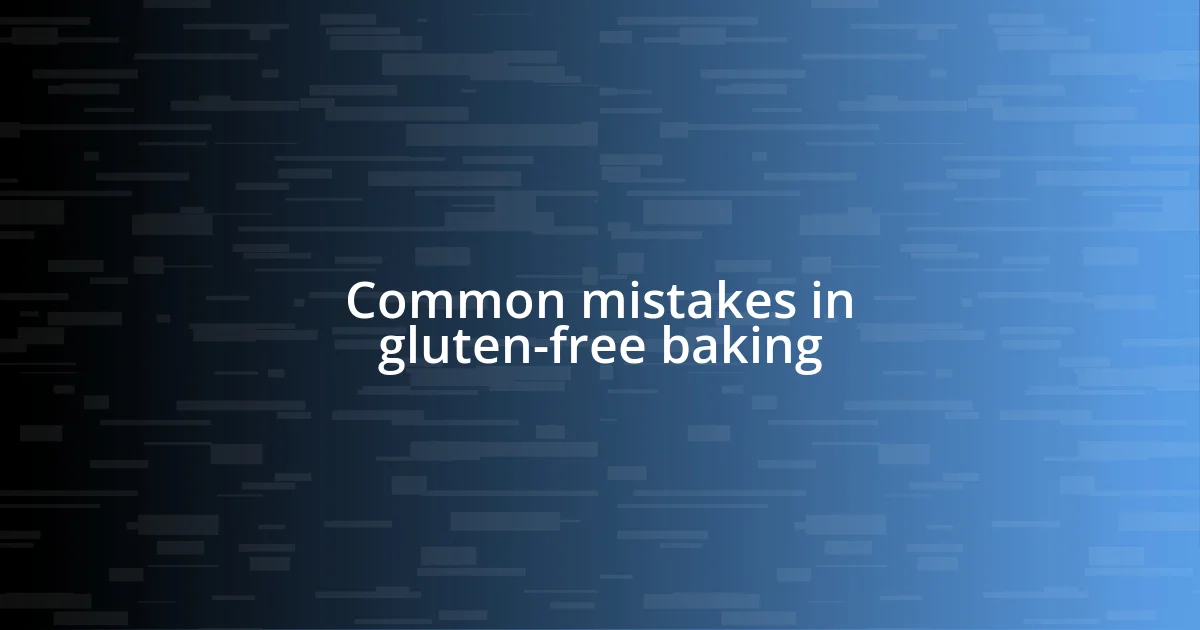Key takeaways:
- Understanding gluten-free baking requires creativity and experimentation with alternative flours and binders to achieve desired textures.
- Key ingredients like xanthan gum, natural sweeteners, and a mix of gluten-free flours significantly enhance the quality of baked goods.
- Avoid common mistakes such as incorrect flour measurements and inadequate resting times, which affect the final product’s texture and quality.

Understanding gluten-free baking
When I first ventured into gluten-free baking, I was genuinely surprised by how different the experience was from traditional baking. There’s something fascinating about understanding that gluten, which is a protein found in wheat, barley, and rye, is responsible for the chewy texture we love in bread and pastries. Without gluten, I quickly realized that achieving the same texture requires a bit of creativity and a good grasp of alternative ingredients.
I remember my initial attempts with gluten-free flours, like almond or coconut flour, were a mixed bag of successes and failures. Have you ever baked a cake that turned out like a brick? It’s disheartening! But through trial and error, I found that blending different flours can create a balance of flavors and textures that mimic what gluten typically provides. Using xanthan gum or flaxseed meal as binders became a game changer for me—adding that essential structure and moisture to my bakes.
At its core, gluten-free baking is not just about avoiding gluten; it’s about exploring a world of new flavors and ingredients. With each experiment, I’ve noticed a growing appreciation for the unique qualities of gluten-free flours. It’s exciting to see how gluten-free options can cater to various dietary needs while still allowing for creativity and enjoyment in the kitchen. Don’t you feel inspired to get in there and play around with different combinations?

Benefits of gluten-free recipes
The benefits of gluten-free recipes extend beyond just dietary restrictions. For those with gluten sensitivities or celiac disease, these recipes are not merely an alternative—they’re essential for health and well-being. I recall a friend of mine who struggled with digestive issues for years before discovering she was gluten intolerant. Once she adjusted her diet, there was a noticeable change in her energy levels and overall mood. It’s remarkable how the right diet can reshape our lives.
Here’s a quick rundown of the benefits:
- Improved Digestive Health: Many people find relief from bloating and discomfort by eliminating gluten.
- Increased Nutrient Variety: Gluten-free flours often include a diverse array of whole grains, nuts, and seeds, enriching one’s diet.
- Boosted Energy Levels: Without gluten, many folks experience a greater sense of vitality, as their bodies better absorb the nutrients they consume.
- Enhanced Creativity in Baking: Experimenting with unique ingredients allows for exciting new flavors and textures.
By embracing gluten-free baking, I’ve discovered a world full of culinary possibilities that I never knew existed. It’s a bit like a treasure hunt—each flour and ingredient can lead to delightful surprises.

Key ingredients for gluten-free baking
When I dive into gluten-free baking, I find it essential to have a solid understanding of the key ingredients that will elevate my bakes. For instance, I’ve found that using a combination of gluten-free flours, such as almond flour and brown rice flour, not only enhances the flavor but also creates a pleasing texture. Recently, I whipped up some gluten-free chocolate chip cookies using a blend of these flours, and I was genuinely delighted by their chewy goodness yet sturdy enough to hold together.
Another ingredient that often surprises people is xanthan gum. I was initially skeptical about adding it, thinking it might ruin my creations, but in truth, it acts as a fantastic binder and gives the dough that elasticity we crave. I recall baking a gluten-free pizza crust where I added just the right amount of xanthan gum. The crust turned out beautifully crispy on the outside and chewy on the inside, creating a pizza experience I thought was lost forever. It’s amazing how pivotal such small ingredients can be!
When embarking on gluten-free baking, I recommend not overlooking the role of natural sweeteners like maple syrup or honey. These add moisture and a lovely depth of flavor that can enhance your baked goods. For example, I’ve made gluten-free pancakes using honey, and they turned out light and fluffy—definitely not the dense texture I initially feared I’d get. The key here is to embrace the variety and find what best suits your taste. With these ingredients, the gluten-free baking adventure is truly exciting.
| Ingredient | Purpose |
|---|---|
| Gluten-Free Flours | Provide flavor and texture; blend for best results. |
| Xanthan Gum | Binds ingredients; creates elasticity. |
| Natural Sweeteners | Add moisture and enhance flavor. |

Essential tools for gluten-free baking
When it comes to my gluten-free baking journey, having the right tools really makes a difference. For example, I’ve found that a good set of measuring cups and spoons is absolutely non-negotiable. Trust me, it’s crucial to measure dry ingredients with precision to avoid any baking disasters. The first time I eyeballed an ingredient, I ended up with a flat, sad excuse for a cake that left me questioning my skills.
An electric mixer has also become my best friend in the kitchen. I’ll never forget the time I attempted to make gluten-free bread by hand. After multiple minutes of mixing, my arms were sore, and I was left with a dough that resembled concrete more than anything edible. Honestly, a sturdy stand mixer would have saved me a lot of elbow grease and disappointment! When I finally invested in one, I noticed that my dough consistency improved dramatically, which meant tastier results and more smiles all around.
Lastly, investing in quality baking pans is essential for achieving that perfect rise. I remember a batch of gluten-free muffins that came out unevenly browned. It dawned on me that my pans were likely the culprit. Switching to heavier, non-stick pans transformed my baking game. Have you ever had the pleasure of pulling perfectly golden muffins from the oven? It’s a little victory that keeps me coming back for more. Each tool plays its part in making gluten-free baking not just possible but truly enjoyable!

Common mistakes in gluten-free baking
It’s so easy to fall into common traps when gluten-free baking. One mistake I constantly encounter is underestimating the importance of measuring flour correctly. The first time I felt confident enough to just scoop my almond flour, the result was a cookie dough that could hardly hold its shape. After a little trial and error, I learned that leveling off my measurements provides the consistency I need for reliable results.
Another error that I’ve made is overlooking the resting time for gluten-free batters or doughs. I vividly remember making gluten-free pancakes without allowing the batter to rest. They ended up dense and flat, which was so disappointing. Once I started giving my mixtures a little time to hydrate, I noticed a remarkable difference. The pancakes became fluffy and delightful. It makes me wonder—how many other hidden gems are waiting to be discovered by simply adjusting our methods?
Lastly, people often forget that gluten-free baked goods require different baking times and temperatures. I learned this the hard way when my gluten-free bread came out a bit too dry because I followed a traditional recipe’s timing. It was an uphill battle getting that loaf just right. Now, I always keep a close eye on my treats and rely on a toothpick to really know when they’re done. Isn’t it fascinating how small tweaks can lead to a complete transformation in our baking journey?

Tips for perfect gluten-free baked goods
One essential tip I’ve picked up is to always add a binding agent when baking gluten-free. The first time I made gluten-free cookies, I used solely almond flour, thinking I could skip the binding ingredient. The result? Crumbly messes that fell apart as soon as you picked them up! By incorporating an egg or a chia seed gel, I noticed a remarkable improvement in texture; my cookies not only stayed together but also had a delightful chewiness. Have you ever had that “aha!” moment when something just clicks in the kitchen?
Experimentation with flour blends is another golden rule. When I first dabbled in gluten-free baking, I stuck to one type of flour, which led to predictable—and not-so-great—results. It wasn’t until I started mixing coconut flour with oat flour that I unlocked a new world of flavor and texture. It’s like discovering hidden melodies in your favorite song; the right combination can make all the difference. Have you tried creating your own unique blend yet?
Lastly, considering humidity and temperature in your baking environment is crucial for gluten-free success. During one hot summer, I noticed my batter behaving oddly—too runny and just off. After some research, I learned that humidity can affect how flours absorb liquids. I started adjusting my recipes by reducing liquid slightly on those sweltering days. Have you ever encountered a baking challenge that just seemed impossible until you discovered the environmental factors at play? It’s incredible how much our surroundings influence the cooking process!

Experimenting with gluten-free recipes
Experimenting with gluten-free recipes can feel like embarking on a culinary adventure. I remember the first time I tried using a flour blend in my baking. I was both excited and nervous—excited because I could customize my flour mix, but nervous about what the result would be. After blending brown rice flour with tapioca flour, I was amazed at how the texture improved, giving me beautifully light muffins that didn’t crumble apart. Have you ever experienced that moment of discovery where you realize your culinary creations can evolve?
Another area worth exploring is the use of alternative sweeteners. The first time I swapped sugar for honey in my gluten-free brownies, the flavor was off the charts! I was blown away by how that simple change made the brownies not only sweeter but also moister. It made me wonder—what other substitutions could enhance my recipes even further? Playing with ingredients adds a dynamic element to baking, allowing for creativity that transforms how we experience flavor and texture.
Let’s not forget the importance of trying new techniques. One day, I decided to experiment with a steam bake method for my gluten-free bread. The result was a soft crust that I never thought was possible with gluten-free flour! It made me think—how many other traditional baking techniques could I adapt to improve my gluten-free creations? Stepping out of our comfort zones can lead to the most delightful surprises in baking, don’t you think?












